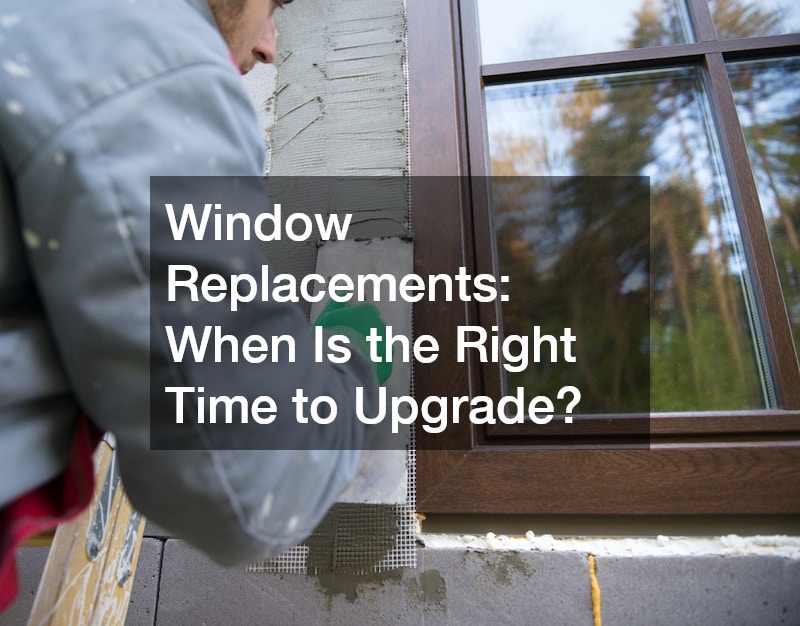An overview of the importance of knowing the right timing for window replacements, including potential benefits and consequences of delaying such a decision. Replacing windows at the appropriate time can significantly impact your home’s energy efficiency and overall value. Conversely, delaying this process may lead to escalated utility costs, damage, and eventual discomfort within your living spaces.
How to Know When It’s Time to Replace Your Windows
Signs Your Windows Need Replacement
Several signs indicate the need for window replacements, primarily drafts entering through the window frames. This issue usually signifies failing seals or decaying materials, causing inefficiency. Dampness, difficulty in opening or closing, visible rot, or cracked frames are other signs homeowners should not overlook.
Condensation between glass layers also points to diminishing performance, suggesting possible seal failures. Over time, windows that once operated smoothly may begin to stick, due to warping or swelling from moisture. Additionally, peeling paint around the openings may indicate ongoing water intrusion issues.
It’s crucial to address these symptoms early to prevent further complications. Prolonged exposure to such conditions can expedite the degradation of the window structure. As a result, timely assessment and decision-making are pivotal in maintaining home integrity and comfort.
Assessing Window Performance
Evaluating your windows’ performance is vital in determining the need for replacements. This process involves several assessments such as checking for energy efficiency using thermal imaging tools or infrared cameras. An increase in energy bills is often an indicator of inefficiency, typically caused by compromised windows.
A room’s temperature inconsistencies can also point towards under-performing windows. Condensation issues might not only impact window efficiency but also promote mold growth, which can affect indoor air quality. Hence, conducting regular checks aids in detecting underlying problems early.
Another evaluation approach involves physically inspecting the windows for soundness and airtightness. Comprehensive examinations might involve professional audits to gauge performance standards against modern criteria. This proactive stance assists homeowners in catching signs of wear before they necessitate costly repairs.
The Benefits of Replacing Old Windows
Energy Efficiency and Cost Savings
Modern window replacements significantly enhance energy efficiency and can lead to cost savings. These technologically advanced windows are designed to limit thermal transfer, keeping houses warm in winters and cool during summers. Such efficiency improvements directly translate to reduced energy consumption and consequent bills.
Some reports indicate up to a 15% reduction in heating and cooling costs after replacing old windows. With heightened insulation capabilities, homeowners experience a notable improvement in indoor comfort. Furthermore, energy-efficient windows contribute positively to environmental sustainability by decreasing carbon footprints.
Pairing new windows with energy-efficient practices can further amplify these cost savings. This holistic approach ensures optimal home comfort while being financially prudent. Besides, utility rebates and tax incentives for using energy-efficient fixtures offer additional financial benefits to homeowners.
Increase in Home Value and Aesthetic Appeal
Upgraded windows can significantly increase a home’s value and its aesthetic charm. Well-designed windows contribute to curb appeal, making the property visually appealing and potentially attracting prospective buyers. The prospect of a reduced need for future renovations itself becomes an attractive selling feature.
Replacing windows with modern, stylish designs allows homeowners to customize appearances, enhancing their personal style. New windows can seamlessly integrate with home designs, contributing to an updated and cohesive look. These improvements often lead to a higher appraisal value, rewarding the homeowner’s investment.
Moreover, newer windows come with functional benefits that outdated models might lack. Enhanced security features, noise-reducing capabilities, and low maintenance requirements are among the attractive selling points. These collective benefits underscore the value-enhancing potential of window replacements.
Types of Window Replacements Available
Material Options: Wood, Vinyl, Aluminum, and Fiberglass
Homeowners have several material options when choosing window replacements: wood, vinyl, aluminum, and fiberglass, each offering unique advantages. Wood provides timeless appeal and natural insulation, but often requires more maintenance. Vinyl is budget-friendly and resistant to moisture, making it an increasingly popular choice.
Aluminum windows are lightweight yet robust, offering superior durability ideal for contemporary architecture. However, their conductive nature can affect insulation efficacy. Fiberglass presents an optimal solution, balancing aesthetics, durability, and insulating properties.
Selection typically depends on homeowner priorities, budget, and climate considerations. Each material caters to specific design preferences and practical needs. It is advisable to evaluate each option’s pros and cons regarding durability, cost, and maintenance necessities before deciding.
Style Options: Double-Hung, Casement, Sliding, and More
Windows today come in a myriad of styles—double-hung, casement, and sliding being among the most common. Double-hung windows, characterized by their two operable sashes, are versatile and suited for traditional settings. Casement windows, which open outward on hinges, offer unobstructed views and better ventilation options.
Sliding windows operate horizontally, making them ideal for spaces where vertical space is limited. Additionally, more specialized styles like bay, bow, and garden windows serve distinct aesthetic and functional purposes. Selecting an appropriate style is crucial for maximizing a window’s usability and compatibility with the home’s design.
Homeowners have a plethora of material and style choices, each catering to different priorities and preferences. Understanding these factors helps ensure successful and satisfying window upgrade projects. Ultimately, replacing windows not only revitalizes a home’s appearance but also enhances safety, comfort, and long-term savings.
An overview of the importance of knowing the right timing for window replacements, including potential benefits and consequences of delaying such a decision. Replacing windows at the appropriate time can significantly impact your home’s energy efficiency and overall value. Conversely, delaying this process may lead to escalated utility costs, damage, and eventual discomfort within your living spaces.
How to Know When It’s Time to Replace Your Windows
Signs Your Windows Need Replacement
Several signs indicate the need for window replacements, primarily drafts entering through the window frames. This issue usually signifies failing seals or decaying materials, causing inefficiency. Dampness, difficulty in opening or closing, visible rot, or cracked frames are other signs homeowners should not overlook.
Condensation between glass layers also points to diminishing performance, suggesting possible seal failures. Over time, windows that once operated smoothly may begin to stick, due to warping or swelling from moisture. Additionally, peeling paint around the openings may indicate ongoing water intrusion issues.
It’s crucial to address these symptoms early to prevent further complications. Prolonged exposure to such conditions can expedite the degradation of the window structure. As a result, timely assessment and decision-making are pivotal in maintaining home integrity and comfort.
Assessing Window Performance
Evaluating your windows’ performance is vital in determining the need for replacements. This process involves several assessments, such as checking for energy efficiency using thermal imaging tools or infrared cameras. An increase in energy bills is often an indicator of inefficiency, typically caused by compromised windows.
A room’s temperature inconsistencies can also point towards under-performing windows. Condensation issues might not only impact window efficiency but also promote mold growth, which can affect indoor air quality. Hence, conducting regular checks aids in detecting underlying problems early.
Another evaluation approach involves physically inspecting the windows for soundness and airtightness. Comprehensive examinations might involve professional audits to gauge performance standards against modern criteria. This proactive stance assists homeowners in catching signs of wear before they necessitate costly repairs.
The Benefits of Replacing Old Windows
Energy Efficiency and Cost Savings
Modern window replacements significantly enhance energy efficiency and can lead to cost savings. These technologically advanced windows are designed to limit thermal transfer, keeping houses warm in winters and cool during summers. Such efficiency improvements directly translate to reduced energy consumption and consequent bills.
Some reports indicate up to a 15% reduction in heating and cooling costs after replacing old windows. With heightened insulation capabilities, homeowners experience a notable improvement in indoor comfort. Furthermore, energy-efficient windows contribute positively to environmental sustainability by decreasing carbon footprints.
Pairing new windows with energy-efficient practices can further amplify these cost savings. This holistic approach ensures optimal home comfort while being financially prudent. Besides, utility rebates and tax incentives for using energy-efficient fixtures offer additional financial benefits to homeowners.
Increase in Home Value and Aesthetic Appeal
Upgraded windows can significantly increase a home’s value and its aesthetic charm. Well-designed windows contribute to curb appeal, making the property visually appealing and potentially attracting prospective buyers. The prospect of a reduced need for future renovations itself becomes an attractive selling feature.
Replacing windows with modern, stylish designs allows homeowners to customize appearances, enhancing their personal style. New windows can seamlessly integrate with home designs, contributing to an updated and cohesive look. These improvements often lead to a higher appraisal value, rewarding the homeowner’s investment.
Moreover, newer windows come with functional benefits that outdated models might lack. Enhanced security features, noise-reducing capabilities, and low maintenance requirements are among the attractive selling points. These collective benefits underscore the value-enhancing potential of window replacements.
Types of Window Replacements Available
Material Options: Wood, Vinyl, Aluminum, and Fiberglass
Homeowners have several material options when choosing window replacements: wood, vinyl, aluminum, and fiberglass, each offering unique advantages. Wood provides timeless appeal and natural insulation, but often requires more maintenance. Vinyl is budget-friendly and resistant to moisture, making it an increasingly popular choice.
Aluminum windows are lightweight yet robust, offering superior durability ideal for contemporary architecture. However, their conductive nature can affect insulation efficacy. Fiberglass presents an optimal solution, balancing aesthetics, durability, and insulating properties.
Selection typically depends on homeowner priorities, budget, and climate considerations. Each material caters to specific design preferences and practical needs. It is advisable to evaluate each option’s pros and cons regarding durability, cost, and maintenance necessities before deciding.
Style Options: Double-Hung, Casement, Sliding, and More
Windows today come in a myriad of styles—double-hung, casement, and sliding being among the most common. Double-hung windows, characterized by their two operable sashes, are versatile and suited for traditional settings. Casement windows, which open outward on hinges, offer unobstructed views and better ventilation options.
Sliding windows operate horizontally, making them ideal for spaces where vertical space is limited. Additionally, more specialized styles like bay, bow, and garden windows serve distinct aesthetic and functional purposes. Selecting an appropriate style is crucial for maximizing a window’s usability and compatibility with the home’s design.
Homeowners have a plethora of material and style choices, each catering to different priorities and preferences. Understanding these factors helps ensure successful and satisfying window upgrade projects. Ultimately, replacing windows not only revitalizes a home’s appearance but also enhances safety, comfort, and long-term savings.




